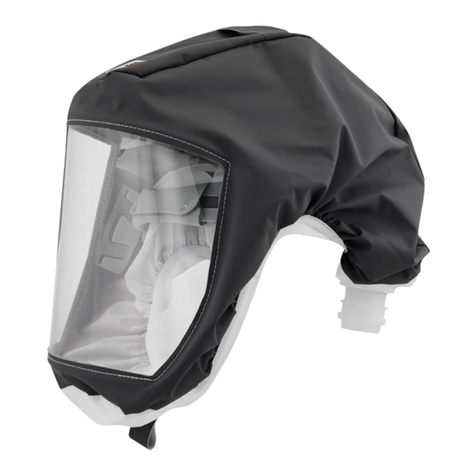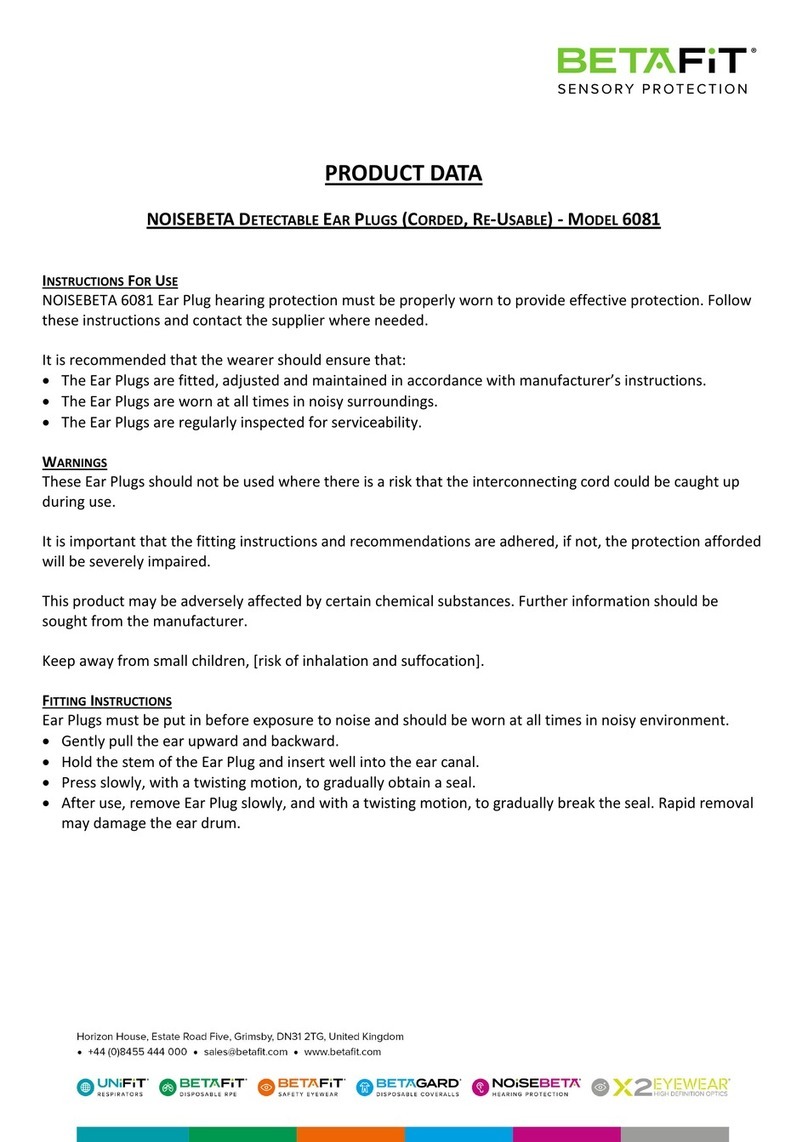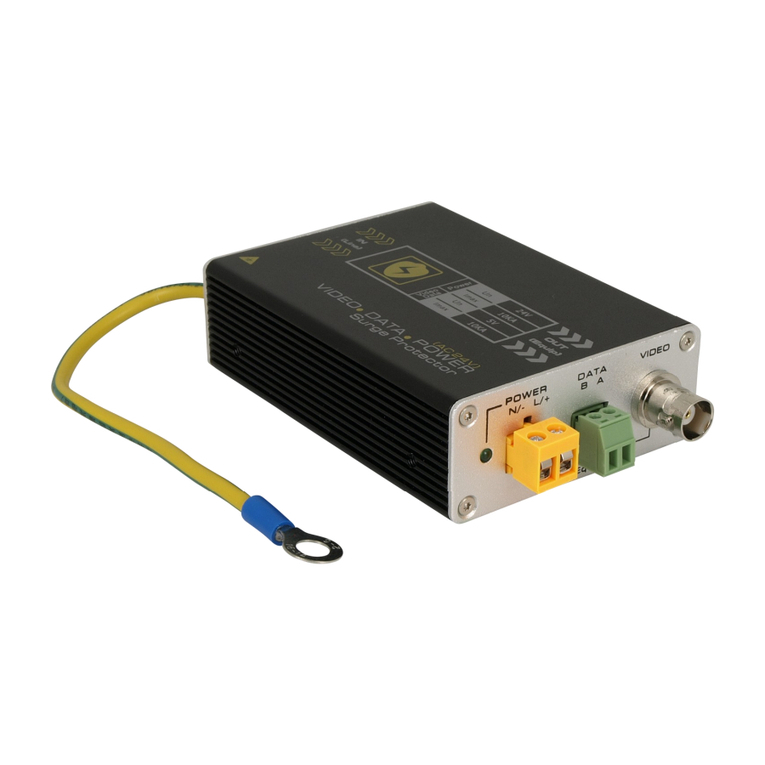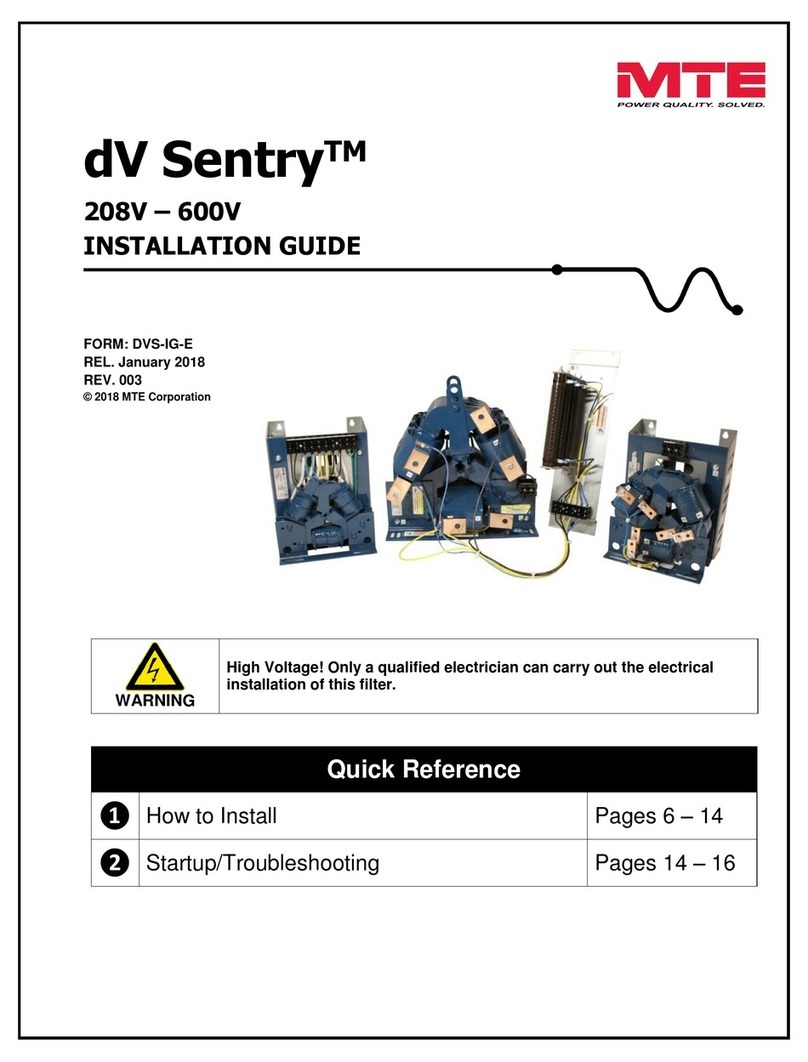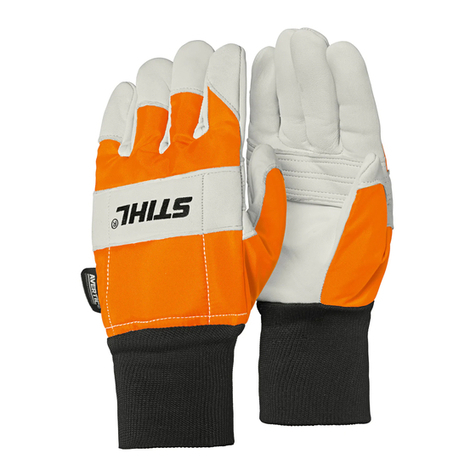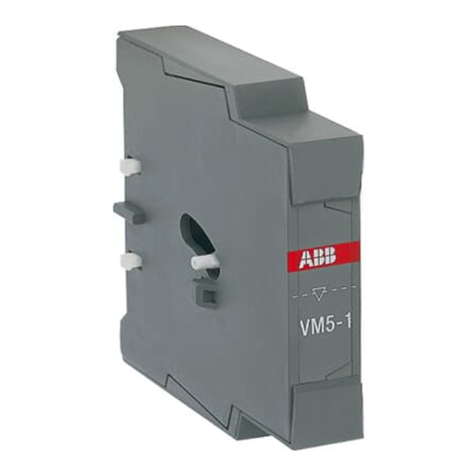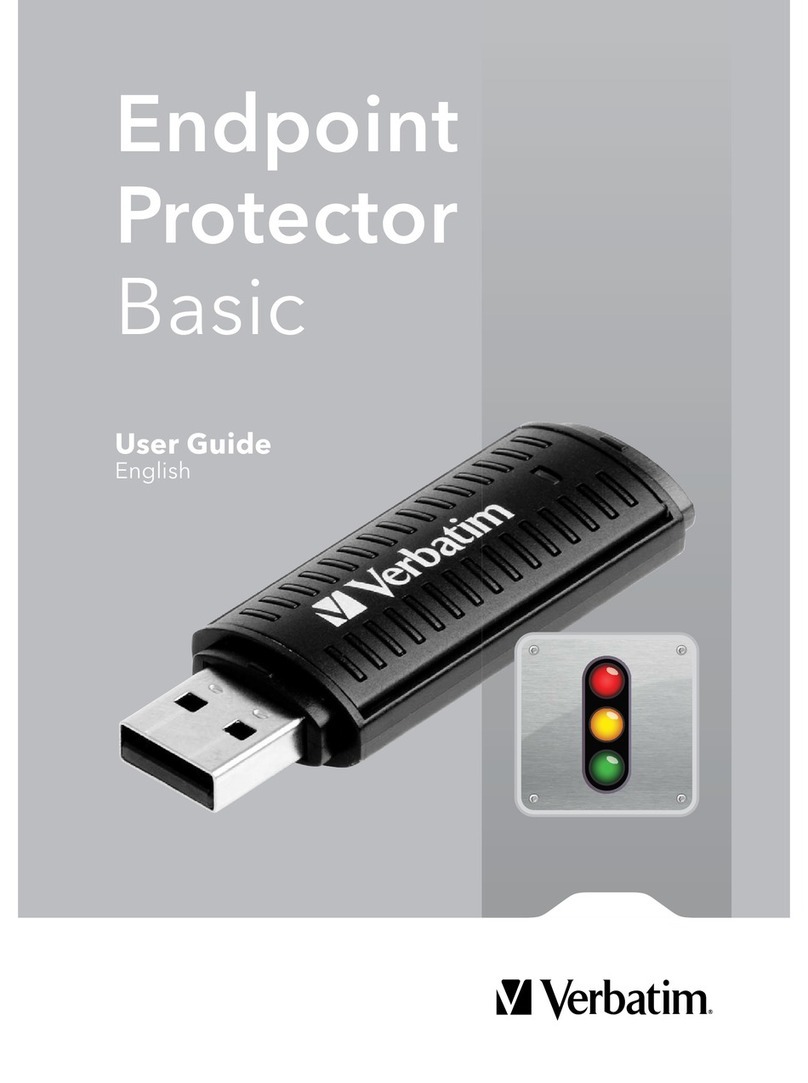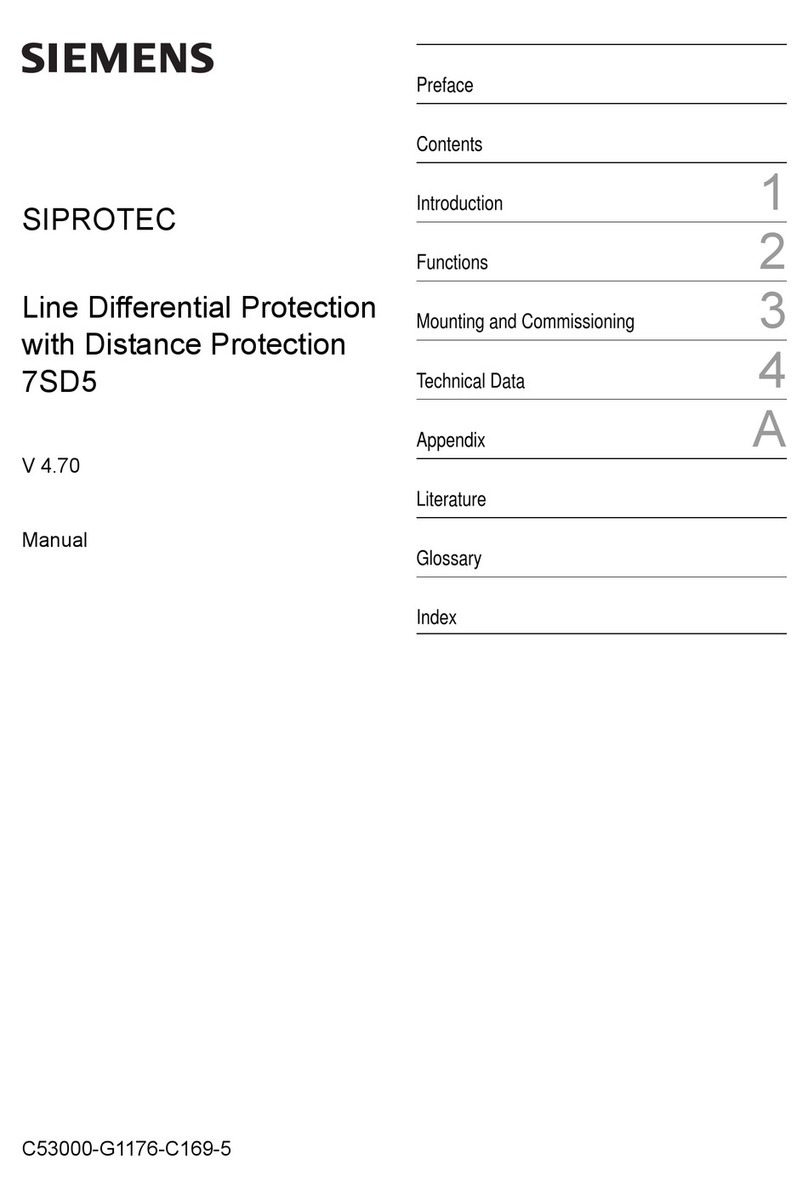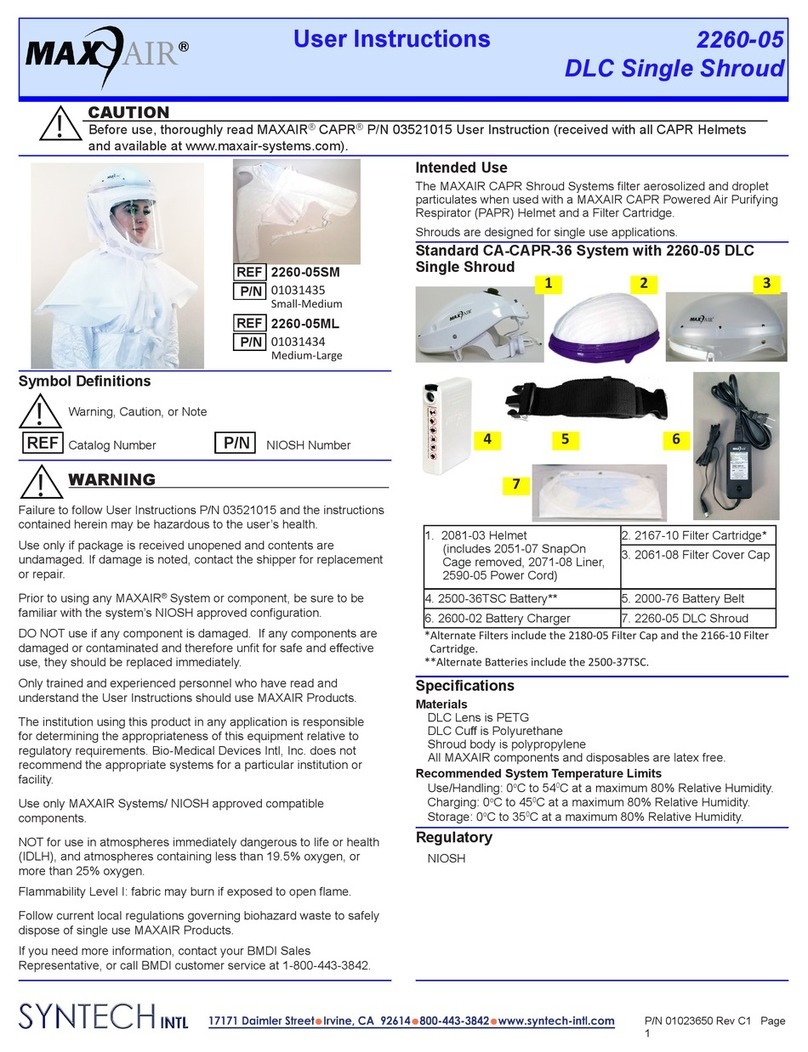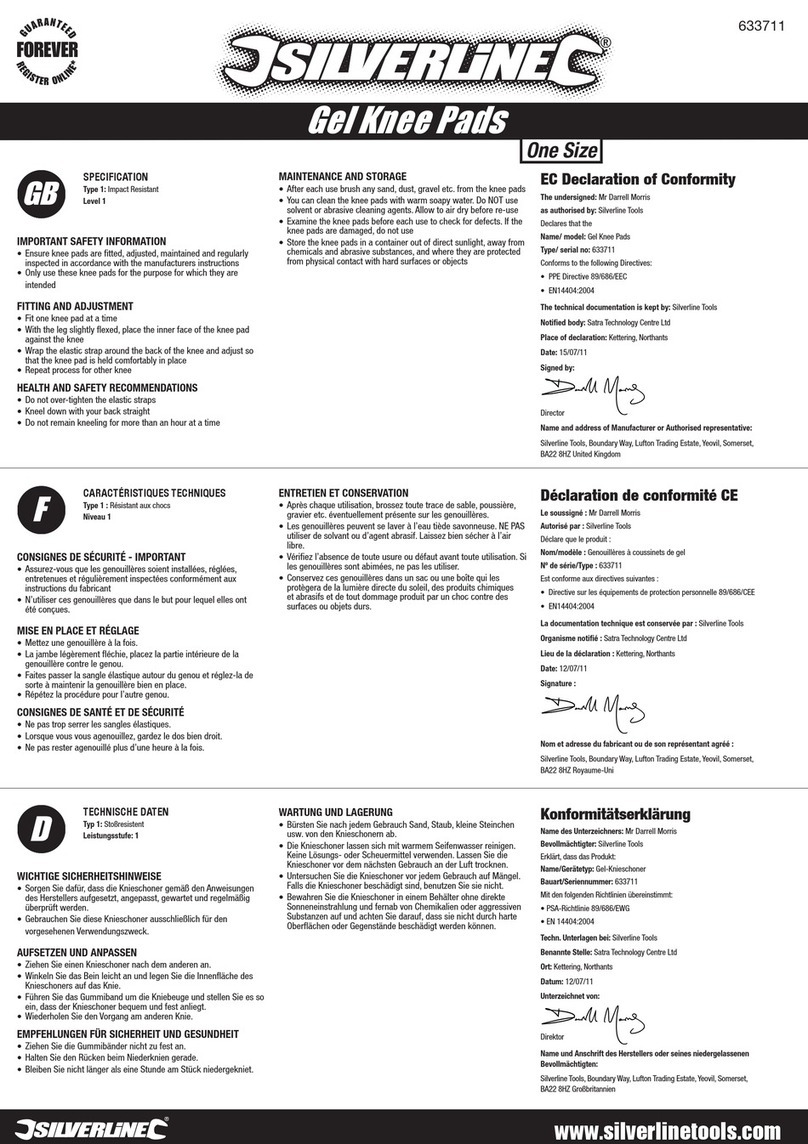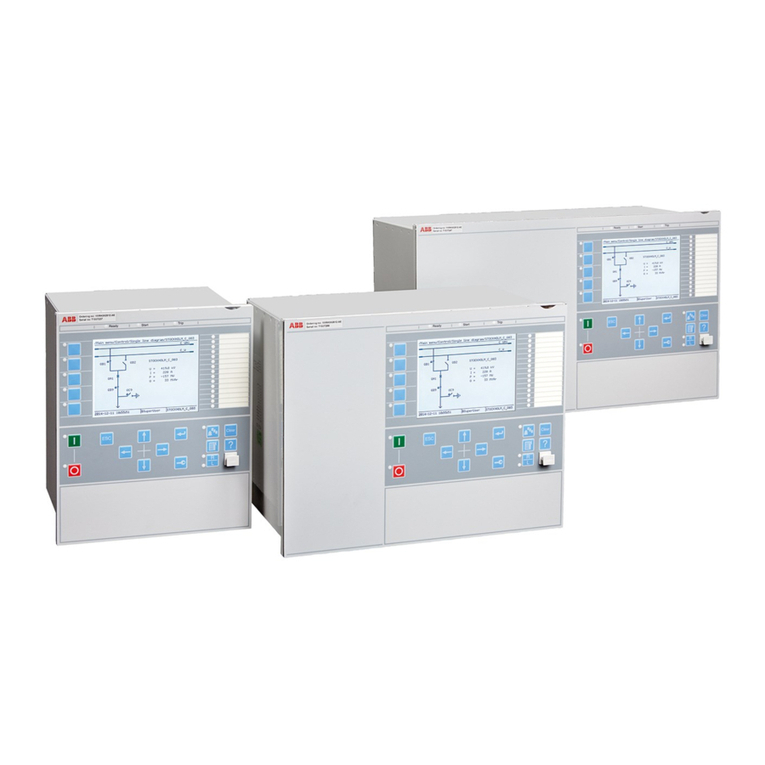Diadora UTILITY 702.173551 User manual

INFORMATIVNA ZABILJEŠKA HR
FRÓÐLEGUR MINNISPUNKTUR
IS
ΣΗΜΕΙΩΣΗ ΕΝΗΜΕΡΩΣΗΣ EL
INFORMATIEVE NOTA NL
INFORMASJONSSKRIV NO
TIEDOTE
FI
OPLYSNINGSSKEMA DA
NOTĂ INFORMATIVĂ RO
TEABELEHT ET
INFORMACINIS LAPAS
LT
INFORMATĪVĀ PIEZĪME LV
IT
DE
FR
ES
SE
SI
HU
PT
Diadora S.p.A.
via Montello 80
31031 Caerano di San Marco (TV)
C. F. e P. IVA IT 04308510264
www.diadora.com
COD.: RM30.034744 - Update 30/09/2020


3
EN 342:2017
IT NOTA INFORMATIVA
INDUMENTI PER LA PROTEZIONE CONTRO IL FREDDO
Articolo: 702.173551
PRODUTTORE: Diadora S.p.a Via Montello, 80 –31031 Caerano di San Marco –Treviso -Italy
Gli indumenti per la protezione contro il freddo sono Dispositivi di Protezione Individuale (DPI) e sono soggetti ai
requisiti del Regolamento 2016/425. La marcatura CE èobbligatoria per la commercializzazione. Sono Dispositivi di
Protezione Individuale di II categoria e sono stati sottoposti a certificazione CE presso l’Organismo Notificato n.0498
Ricotest S.r.l Via Tione,9 –37010 Pastrengo (VR).
Per ulteriori informazioni e per Dichiarazioni di Conformità vedi il sito internet: www.utilitydiadora.com/declarations.
AVVERTENZE:
La legge responsabilizza il datore di lavoro per quanto riguarda l’adeguatezza del DPI al tipo di rischio presente
(caratteristiche del DPI e categoria di appartenenza). Prima dell’impiego verificare la corrispondenza delle
caratteristiche del modello scelto alle proprie esigenze d’utilizzo. Gli indumenti per la protezione contro il freddo
prodotti da Diadora, sono progettati e costruiti in funzione del rischio da cui salvaguardarsi e in conformità alle
seguenti norme europee:
EN ISO 13688: 2013 : REQUISITI GENERALI PER L’ABBIGLIAMENTO DI SICUREZZA.
EN 342:2017: INDUMENTI PER LA PROTEZIONE CONTRO IL FREDDO.
Tutti i materiali utilizzati, siano di provenienza naturale o sintetica, nonché le tecniche applicate di lavorazione sono
stati scelti per soddisfare le esigenze espresse dalla suddette normative tecniche Europee in termini di sicurezza,
ergonomia, comfort, solidità ed innocuità.
Isolamento termico
L'isolamento termico di un indumento è classificato sulla base dei valori di isolamento misurati. Le prestazioni di un
indumento in termini di conservazione dell'equilibrio termico a temperatura corporea normale dipendono dalla
produzione interna di calore corporeo. Pertanto, il valore protettivo di un indumento viene valutato confrontando il suo
valore di isolamento “misurato”e il valore di isolamento richiesto “calcolato”.
Permeabilità all’aria (AP)
La permeabilità all’aria di un tessuto è la velocità di attraversamento di un flusso d’aria noto che passa
perpendicolarmente attraverso una provetta in condizioni specifiche di
area, caduta di pressione e tempo secondo lo standard UNI EN ISO 9237:97
L'isolamento termico effettivo risultante deve essere calcolato con la formula: Icler= Itr-Iar
Itr = è l’isolamento termico totale della pelle all’ambiente esterno, includendo l’indumento e lo strato limite dell’aria
misurato con un manichino mobile (che muove braccia e gambe) in condizioni definite secondo EN ISO 15831:2004
in m2*K/W.
Iar= è il risultato dell’isolamento termico dello strato limite dell’aria dell’indumento misurato con un manichino mobile
in condizioni definite secondo EN ISO 15831:2004 in m2*K/W.
AP
mm/s Class
100>AP
1
5<AP≤100
2
AP≤5
3
Classe1: indumenti adatti a basse velocità
dell’aria, inferiori a 1m/s, come ad esempio in
ambienti freddi.
Classe2: adatti a velocità dell’aria inferiori a
5m/s
Classe3: adatti a alte velocità dell’aria ≥5m/s

4
Icler: Isolamento termico in condizioni definite, tra la pelle e la superficie esterna dell’indumento misurato tramite un
manichino mobile. Il valore dell’isolamento termico Icler è determinato in relazione alla superficie nuda del corpo. Il suo
valore è espresso in m2*K/W.
ISOLAMENTO TERMICO DEGLI INDUMENTI E CONDIZIONI DI TEMPERATURA AMBIENTE PER L’EQUILIBRIO
TERMICO A DIVERSE DURATE DI ESPOSIZIONE
Isolamento
Icler
m2*K/W
Utilizzatore quando fermo
75 W/m
2
Velocità dell’aria
0,4 m/s
3 m/s
8h
1h
8h
1h
0,265 13 0 19 7
0,310 10 -4 17 3
0,390 5 -12 13 -3
0,470 0 -20 7 -9
0,540 -5 -26 4 -14
0,620
-10
-32
0
-20
ISOLAMENTO TERMICO DELL’ABBIGLIAMENTO E CONDIZIONI DI TEMPERATURA AMBIENTE PER
L’EQUILIBRIO TERMICO A DIVERSI LIVELLI DI ATTIVITA’ E DURATA DELL’ESPOSIZIONE.(TAB2)
Isolamento
Icler
m2*K/W
Utilizzatore in movimento
Leggero 115 W/m2
Medio 170 W/m2
Velocità dell’aria
0,4 m/s 3m/s
0,4m/s
3m/s
8h 1h 8h 1h 8h 1h 8h 1h
0.265 3 -12 9 -3
-12
-28
-2
-16
0,310 -2 -18 6 -8
-18
-36
-7
-22
0,390 -9 -28 0 -16
-29
-49
-16
-33
0,470 -17 -38 -6 -24
-40
-60
-24
-43
0,540 -24 -45 -11 -30
-49
-71
-32
-52
0,620 -31 -55 -17 -38
-60
-84
-40
-61

5
ETICHETTATURA: MARCATURA modello:702.173551
Si prega di notare che le marcature sopraindicate sono a puro titolo esplicativo e che sono da ritenere corrette le sole
dimensioni riportate sul capo.
IMPIEGHI POTENZIALI:
Lavori nel settore edilizia, agroalimentare, pesca, agricoltura, professioni in ambienti di lavoro umidi ed enti pubblici a
seconda del rischio ed ogni qualvolta sia richiesta la protezione contro il freddo(per esempio umidità e vento e a
temperature ≤-5C°) come indicato dalla norma EN 342:2017.
Attenzione: in base alla condizioni locali come condizioni metereologiche o ambientali può essere richiesta una
classe più alta.
Per una protezione completa del corpo, abbinare altri DPI con prestazioni analoghe.
PRESTAZIONI ED ISTRUZIONI PER L’USO:
Indumenti per la protezione contro il freddo per le caratteristiche di resistenza al freddo e all’aria (a seconda di
quanto indicato sul capo e alla classe di appartenenza).
Questo capo è indicato per l’utilizzo alle seguenti condizioni:
- ambienti freddi,
- utilizzo esterno, con velocità dell’aria inferiori a 1 m/s.
LIMITI D’USO E RISCHI:
questo DPI non garantisce la protezione da rischi diversi da quelli per cui è stato progettato, che sono minimi e
relativi alle sole condizioni atmosferiche avverse come il freddo entro i limiti dei livelli riportati in marcatura, secondo
la norma EN 342:2017.
Codice e
Informazion
i prodotto
Identificazione del fabbricante
Pittogramma
EN 342:2017
Icler 0,290 m2K/W
(R)
AP class 1
Normativa di riferimento
Valore d’isolamento termico
Classe di permeabilità all’aria
Valore d’isolamento termico
Classe di permeabilità all’aria
Marcatura CE
Normativa di riferimento
Campo taglie

6
- prima di indossare tale capo verificare che non sia né sporco né deteriorato, CONDIZIONI CHE
COMPORTEREBBERO UNA DIMINUZIONE DELLA PROPRIA EFFICACIA.
- la non corretta manutenzione del capo ne può alterare le proprietà.
- il capo in cattive condizioni di pulizia può offrire minori prestazioni.
- eventuali danni non devono essere riparati dall’utilizzatore.
- non è possibile modificare il capo, inclusi loghi, marchi e personalizzazioni oltre a quelli già esistenti.
-Attenzione: il DPI non fornisce protezione di nessuna parte del corpo in particolare, ma è utilizzato per ripararsi da
condizioni atmosferiche avverse come il freddo.
LIMITI DI IMPIEGO –il capo non protegge da:
•rischio di impigliamento in parti in movimento;
•rischio di aggressioni chimiche (acidi, solventi, ecc.);
•rischio di aggressioni meccaniche (taglio, perforazioni, ecc.);
•rischi di attraversamento e spegnimento di fiamme;
•rischi di scarsa visibilità;
•ogni altro rischio per cui il capo non è stato certificato.
ISTRUZIONI DI MANUTENZIONE:
Si declina ogni responsabilità per eventuali danni e conseguenze che possono derivare da un uso improprio degli
indumenti. È importante, durante la scelta, selezionare modello e misura idonei in base alle specifiche esigenze di
protezione derivanti da un analisi dei rischi. Gli indumenti permettono di mantenere le caratteristiche di sicurezza
indicate solo se regolarmente indossati ed in buono stato di conservazione. Verificare con un attento esame visivo
prima di ogni impiego il perfetto stato di conservazione del dispositivo e provvedere alla sua sostituzione nel caso si
ravvisassero fenomeni di alterazione.
ISTRUZIONI DI LAVAGGIO:
LAVARE SEPARATAMENTE E A ROVESCIO.
NON STIRARE SU RINFRANGENTE, STAMPA E PARTI IN GOMMA E ZIP.
LAVAGGIO MASSIMO 40° (5 cicli di lavaggio)
NO CANDEGGIO.
STIRARE MASSIMO 110°
SE STIRO INTERPORRE PANNO DI COTONE
NON ASCIUGARE A TAMBURO.
NON LAVARE A SECCO.
Inoltre:
Non lasciare in ammollo.
Non utilizzare smacchiatori molto alcalini, detergenti a base di solventi o di micro-emulsioni, non candeggiare. Le
condizioni ambientali come il caldo ed il freddo, i prodotti chimici, la luce del sole o un cattivo utilizzo possono
influenzare in modo significativo la durata del dispositivo. In caso di deterioramento, sostituire il capo con un articolo
nuovo.
STOCCAGGIO:
Riporre il capo al riparo da diretta luce solare, in luogo asciutto e privo di agenti aggressivi. Conservare gli indumenti
nuovi in ambienti asciutti e a temperatura non eccessivamente elevata. Successivamente all’utilizzo, dopo averlo
pulito, depositare l’indumento in luogo areato, asciutto, lontano da fonti di calore e da prodotti che ne possano
compromettere le caratteristiche.
VITA DEL DISPOSITIVO:
La vita del capo dipende dal suo stato generale dopo l’utilizzo, a causa dei numerosi fattori che possono influenzare
la vita utile del dispositivo durante l’utilizzo, non è possibile stabilirne con certezza la durata.
MATERIALI/COMPOSIZIONE DEL CAPO:
SHELL 100% PL
LINING 100% PL
BREATHING SYSTEM 98% PL –2% PA
PADDING 100% PL

7
EN 342:2017
MERKBLATT
KLEIDUNGSSTÜCKE ZUM SCHUTZ GEGEN KÄLTE
Artikel: 702.173551
HERSTELLER: Diadora S.p.a Via Montello, 80 –31031 Caerano di San Marco –Treviso - Italien
Die Kleidungsstücke zum Schutz gegen Kälte sind persönliche Schutzausrüstungen (PSA) und unterliegen den
Anforderungen der Verordnung 2016/425. Die CE-Kennzeichnung ist für die Vermarktung Pflicht. Es sind persönliche
Schutzausrüstungen der Kategorie II und sie wurden der CE-Zertifizierung bei der notifizierten Stelle Nr. 0498
Ricotest S.r.l Via Tione, 9 –37010 Pastrengo (Verona - Italien) unterzogen.
Weitere Informationen und die Konformitätserklärungen finden Sie auf der Internetseite:
www.utilitydiadora.com/declarations.
HINWEISE:
DasGesetzbezieht denArbeitgeber indie Verantwortung mitein,wasdieAngemessenheit der PSAinBezugauf
die vorhandenen
Risiko betrifft (Eigenschaften der PSA und Zugehörigkeitskategorie). Vor dem Gebrauch die Übereinstimmung der Eigenschaften des
gewählten Modells mit den eigenen Verwendungsanforderungen vergleichen.
Die von Diadora hergestellte gegen Kälte wurde
entsprechend des Risikos entworfen, vor dem man sich
schützen möchte und ist mit folgenden europäischen Normen
konform:
EN ISO 13688: 2013: ALLGEMEINE ANFORDERUNGEN FÜR SCHUTZBEKLEIDUNG
EN 342:2017: KLEIDUNGSSTU
CKE ZUM SCHUTZ GEGEN KA
LTE
Alle verwendeten Materialien, ob natürlicher oder synthetischer Herkunft sowie die verwendeten Arbeitstechniken wurden gewählt,
um den Anforderungen der oben zitierten europäischen technischen Norm betreffs Sicherheit,
Ergonomie, Komfort, Robustheit
und Unschädlichkeit zu genügen.
Wärmeisolierung
Die Wärmeisolierung eines Kleidungsstücks wird auf der Grundlage der gemessenen Isolierungswerte klassifiziert.
Die Leistungen eines Kleidungsstückes bezüglich der Beibehaltung eines wärmeneutralen Zustands bei normaler
Körpertemperatur sind abhängig von der körpereigenen Wärmeproduktion. Der Schutzwert eines Kleidungsstücks
wird daher durch Vergleich des gemessenen und des berechneten erforderlichen Isolierungswerts bewertet.
Luftdurchlässigkeit (AP)
Die Luftdurchlässigkeit eines Gewebes ist die Durchflussgeschwindigkeit eines bekannten Luftstroms, der bei
spezifischen Umgebungsbedingungen, Druckabfall und Zeit nach dem Standard UNI EN ISO 9237:97 senkrecht
durch eine Probe hindurchströmt.
Die effiziente Wärmeisolierung ist mit der folgenden Formel zu berechnen: Icler= Itr-Iar
Itr = ist die gesamte Wärmeisolierung der Haut von der Umgebung, einschließlich der Bekleidung und der
Luftgrenzschicht, die mit einer beweglichen Prüfpuppe (Arme und Beine sind Bewegung) bei bestimmten
Bedingungen nach EN ISO 15831:2004 in m2*K/W gemessen wird.
Iar= ist das Ergebnis der Wärmeisolierung der Luftgrenzschicht des Kleidungsstücks, die mit einer beweglichen
Prüfpuppe bei bestimmten Bedingungen nach EN ISO 15831:2004 in m2*K/W gemessen wird.
AP
mm/s
Klasse
100>AP
1
5<AP≤100
2
AP≤5
3
Klasse 1: Kleidungsstücke, die für geringe
Luftgeschwindigkeiten, unter 1m/s, wie in kalten
Umgebungen, geeignet sind.
Klasse 2: für Luftgeschwindigkeiten unter 5m/s
geeignet
Klasse 3: für hohe Luftgeschwindigkeiten ≥5m/s
geeignet
DE

8
Icler: Wärmeisolierung unter bestimmten Bedingungen, zwischen der Haut und der Außenseite des Kleidungsstücks
mit einer mobilen Prüfpuppe gemessen. Der Wert der Wärmeisolierung Icler wird in Relation zur nackten Oberfläche
des Körpers bestimmt. Der Wert wird in m2*K/W ausgedrückt.
WÄRMEISOLIERUNG DER KLEIDUNGSSTÜCKE UND BEDINGUNGEN DER UMGEBUNGSTEMPERATUR FÜR
EINEN WÄRMENEUTRALEN ZUSTAND BEI VERSCHIEDENEN EXPOSITIONSZEITEN
Isolierung
Icler
m2*K/W
Stehender Träger
75 W/m2
Luftgeschwindigkeit
0,4 m/s 3 m/s
8h
1h
8h
1h
0,265
13
0
19
7
0,310
10
-4
17
3
0,390
5
-12
13
-3
0,470
0
-20
7
-9
0,540
-5
-26
4
-14
0,620
-10
-32
0
-20
WÄRMEISOLIERUNG DER BEKLEIDUNG UND BEDINGUNGEN DER UMGEBUNGSTEMPERATUR FÜR EINEN
WÄRMENEUTRALEN ZUSTAND BEI VERSCHIEDENEN TÄTIGKEITSNIVEAUS UND VERSCHIEDENEN
EXPOSITIONSZEITEN (TAB 2)
Isolierung
Icler
m2*K/W
Sich bewegender Träger
gering 115 W/m2
mittel 170 W/m2
Luftgeschwindigkeit
0,4 m/s 3m/s
0,4m/s
3m/s
8h 1h 8h 1h 8h 1h 8h 1h
0.265 3 -12 9 -3
-12
-28
-2
-16
0,310 -2 -18 6 -8
-18
-36
-7
-22
0,390 -9 -28 0 -16
-29
-49
-16
-33
0,470 -17 -38 -6 -24
-40
-60
-24
-43
0,540 -24 -45 -11 -30
-49
-71
-32
-52
0,620 -31 -55 -17 -38
-60
-84
-40
-61

9
ETIKETTIERUNG: KENNZEICHNUNG Modell:
702.173551
BittebeachtenSie, dassdie obigen KennzeichnungenlediglichzurVeranschaulichungdienenunddassdie korrekten
Größen auf dem
Bekleidungsstück angegeben sind.
EINSATZMÖGLICHKEITEN:
Arbeiten in der Baubranche, Nahrungsmittelerzeugung, Fischerei, Landwirtschaft, bei Berufen mit feuchten
Arbeitsumgebungen und in öffentlichen Einrichtungen je nach Gefahren und jedes Mal, wenn ein Kälteschutz
erforderlich ist (z.B. Feuchtigkeit und Wind bei Lufttemperaturen ≤-5C°) laut der Norm EN 342:2017.
Achtung: Aufgrund der vor Ort herrschenden Witterungs- und Umgebungsbedingungen kann eine höhere Klasse
erforderlich sein.
Für einen Ganzkörperschutz ist das Kleidungsstück mit anderen PSA mit vergleichbaren Leistungen zu kombinieren.
LEISTUNGEN UND ANWENDUNGSHINWEISE:
Kleidungsstücke zum Schutz vor Kälte für die Merkmale der Kälte- und Luftwiderstandsfähigkeit (laut den Angaben
auf dem Kleidungsstück und der Zugehörigkeitsklasse).
Dieses Kleidungsstück ist für die Verwendung unter folgenden Bedingungen geeignet:
- Kalte Umgebungen,
- Anwendung im Freien bei Luftgeschwindigkeit unter 1 m/s.
ANWENDUNGSGRENZEN UND RISIKEN:
- diese PSA garantiert nur einen Schutz gegenüber Risiken, für die sie entworfen wurde, der minimal ist und sich
nur auf
Produktcode
und –
informationen
Herstellerangaben
Piktogramm
EN 342:2017
Icler 0,290 m2K/W (R)
AP Klasse 1
Geltende Rechtsvorschriften
Wert der Wärmeisolierung
Klasse der Luftdurchlässigkeit
Wert der Wärmeisolierung
Klasse der Luftdurchlässigkeit
CE-Kennzeichnung
Geltende Rechtsvorschriften
Größenfeld

10
widrige Witterungsbedingungen wie Regen und Feuchtigkeit bezieht und zwar innerhalb der in der Markie
rung angegebenen
Grenzen, wie in der Norm UNI EN 342:2017 angegeben.
- Bevor das Bekleidungsstück angezogen wird, überprüfen, dass es weder schmutzignoch beschädigt ist, WO-
DURCH
SEINE WIRKSAMKEIT GEMINDERTWÜRDE.
-
Wird das Kleidungsstücknicht richtiggepflegt,dann könnensichseine Eigenschaften ändern.
-
Ein unsauberes Bekleidungsstück kann zu niedrigerer Leistung führen.
-
Eventuelle Beschädigungen dürfen nicht vom Benutzer repariert werden.
- Das Bekleidungsstück kann nicht verändert werden (außer den schon vorhandenen), Embleme, Marken und
Individualisierungen eingeschlossen.
-Achtung: die PSA bietet keinem Körperteil besonderen Schutz, sondern dient lediglich dem Schutz vor widrigen
Witterungsbedingungen, wie Kälte.
EINSATZBESCHRÄNKUNGEN –das Kleidungsstück bietet keinen Schutz vor:
•dem Risiko des Verfangens in beweglichen Teilen;
•dem Risiko gegenüber chemischen Wirkstoffen (Säuren, Lösungsmitteln usw.);
•dem Risiko von mechanischen Einwirkungen (Schnitte, Perforationen usw.);
•den Risiken des Durchgangs und des Löschens von Flammen;
•Risiken bei geringer Sichtbarkeit;
•allen anderen Risiken, für die das Kleidungsstück nicht zertifiziert wurde.
PFLEGEANLEITUNG:
Es wird jegliche Verantwortung für Beschädigungen und deren Folgen abgelehnt, die von einem nicht korrekten
Gebrauch der Kleidungsstücke herrühren. Während der Auswahl ist es wichtig, Modell und Größe anhand spe-
zifischer Schutzanforderungen zu wählen, die sich aus der Risikobewertung ergeben. Die Bekleidungsstücke
bewahren die angegebenen Sicherheitseigenschaften nur, wenn sie regelmäßig getragen werden und in einem guten
Zustand sind. Vor jedem Gebrauch den perfekten Zustand der Ausrüstung aufmerksam prüfen und dieses
austauschen, falls Veränderungen bemerkt werden.
PFLEGEANLEITUNG:
SEPARAT UND AUF DIE LINKE SEITE GEDREHT WASCHEN.
NICHT AUF DEN REFLEKTOREN, AUFDRUCKEN, GUMMITEILEN UND REISSVERSCHLÜSSEN BÜGELN.
WASCHEN BEI MAXIMAL 40° C (5 Waschzyklen)
NICHT MIT CHLOR BEHANDELN.
MAXIMAL BEI 110° BÜGELN.
BEIM BÜGELN EIN BAUMWOLLTUCH AUFLEGEN
NICHT IM TROMMELTROCKNER TROCKNEN.
KEINE TROCKENREINIGUNG.
Außerdem:
Nicht eingeweicht lassen.
Keine sehr alkaline Fleckentferner, Waschmittel mit Lösungsmittel oder Mikroemulsionen verwenden, nicht mit Chlor
bleichen. Umweltbedingungen wie Wärme oder Kälte, chemische Produkte, Sonnenlicht oder eine schlechte
Verwendung können Aussehen und Lebensdauer der Bekleidung bedeutend beeinflussen. Bei Verschleiß das
Bekleidungsstück gegen einen neuen Artikel austauschen.
LAGERUNG:
Das Bekleidungsstück vor direkter Sonneneinstrahlung schützen und an einem sauberen Ort, fern von aggressiven
Einflüssen, aufbewahren. Die Bekleidungsstücke an einem trocken und nicht zu warmen Ort aufbewahren. Nach
Verwendung und Reinigung, das Bekleidungsstück an einem belüfteten, trockenen Ort aufbewahren und zwar fern
von Wärmequellen und Produkten, die dessen Eigenschaften gefährden können.
LEBENSDAUER DER AUSRÜSTUNG:
Die Lebensdauer des Bekleidungsstücks beruht auf den allgemeinen Zustand nach der Verwendung. Aufgrund
zahlreicher Faktoren, die die Lebensdauer der Ausrüstung während seiner Verwendung beeinflussen können, kann
eine Lebensdauer nicht sicher festgelegt werden.
MATERIALIEN/ZUSAMMENSETZUNG DES BEKLEIDUNGSSTÜCKS:
SHELL 100% PL
LINING 100% PL
BREATHING SYSTEM 98% PL –2% PA
PADDING 100% PL

11
EN 342:2017
INFORMATION NOTICE
GARMENTS FOR PROTECTION AGAINST COLD
Article: 702.173551
MANUFACTURER: Diadora S.p.a Via Montello, 80 –31031 Caerano di San Marco –Treviso - Italy
Garments for protection against cold are Personal Protective Equipment (PPE) and they are subject to the
requirements of Regulation No. 2016/425. The CE marking is mandatory for marketing. They are Category II
Personal Protective Equipment and have been submitted for CE certification to Notified Body No. 0498 Ricotest S.r.l
Via Tione,9 –37010 Pastrengo (Verona).
For further information and for the Conformity Declarations, visit the following website:
www.utilitydiadora.com/declarations.
WARNINGS:
Thelaw placesresponsibilityontheemployertoensurethesuitabilityofthePPEforthetypeofriskpresent(featu- resofPPEand
relativeclass).Priortouse,checkthatthefeaturesoftheselectedmodelcorrespondtouserneeds.
Protective clothing for protection
against cold manufactured by Diadora is designed and constructed based on the
riskthatneedstobeprotected against,and in
compliancewith the following Europeanstandards:
EN ISO 13688: 2013 : PROTECTIVE CLOTHING - GENERAL REQUIREMENTS.
EN 342:2017: GARMENTS FOR PROTECTION AGAINST COLD.
All natural and synthetic materials used, as well as the techniques adopted for their workmanship, have been
selected in order
to satisfy the requirements expressed by the above-mentioned European technical standards in
terms of safety, ergonomics,
comfort, sturdiness and innocuousness.
Thermal insulation
The thermal insulation of a garment is classified on the basis of measured insulation values. The performance of a
garment in terms of maintaining its thermal balance at normal body temperature depends on the internal body heat
production. Therefore, the protective value of a garment is assessed by comparing its “measured” insulation value
against the “calculated” required insulation value.
Air permeability (AP)
The air permeability of a fabric is the speed at which a specific air stream passes perpendicularly through a
specimen, under specific conditions of area, pressure drop and time as specified by standard UNI EN ISO 9237:97
The resultant effective thermal insulation must be calculated by using the following formula: Icler= Itr-Iar
Itr = is the total thermal insulation from skin to ambient atmosphere, including clothing and boundary air layer,
measured with a moving manikin (moving arms and legs) under the conditions defined in EN ISO 15831:2004
in m2*K/W.
Iar= is the resultant thermal insulation of the boundary air layer of the garment measured with a moving manikin under
the conditions defined in EN ISO 15831:2004 in m2*K/W.
Icler: Thermal insulation under defined conditions, from the skin to the outer clothing surface, measured by using a
moving manikin. The value of thermal insulation Icler is determined in relation to the naked body surface area. The
value is given in m2*K/W.
AP
mm/s Class
100>AP
1
5<AP≤100
2
AP≤5
3
Class1: garments suitable for low air
flow speeds, less than 1m/s, such as
in cool environments.
Class2: suitable for air flow speeds
lower than 5 m/s
Class3: suitable for high air speed
rates ≥5m/s

12
THERMAL INSULATION OF CLOTHING AND AMBIENT TEMPERATURE CONDITIONS FOR HEAT BALANCE
AT DIFFERENT DURATIONS OF EXPOSURE
Insulation
Icler
m2*K/W
Wearer standing activity
75 W/m2
Air speed
0.4 m/s 3 m/s
8h 1h 8h 1h
0.265
13
0
19
7
0.310
10
-4
17
3
0.390
5
-12
13
-3
0.470
0
-20
7
-9
0.540
-5
-26
4
-14
0.620
-10
-32
0
-20
THERMAL INSULATION OF CLOTHING AND AMBIENT TEMPERATURE CONDITIONS FOR HEAT BALANCE
AT DIFFERENT ACTIVITY LEVELS AND DURATIONS OF EXPOSURE (TABLE 2)
Insulation
Icler
m2*K/W
Wearer moving activity
light 115 W/m2
medium 170 W/m2
Air speed
0.4 m/s 3m/s
0.4m/s
3m/s
8h 1h 8h 1h 8h 1h 8h 1h
0.265 3 -12 9 -3
-12
-28
-2
-16
0.310 -2 -18 6 -8
-18
-36
-7
-22
0.390 -9 -28 0 -16
-29
-49
-16
-33
0.470 -17 -38 -6 -24
-40
-60
-24
-43
0.540 -24 -45 -11 -30
-49
-71
-32
-52
0.620 -31 -55 -17 -38
-60
-84
-40
-61

13
LABELLING: Model MARKING : 702.173551
Please notethatthe above markingsare forillustrative purposes only and thattheactual dimensions areprovided on
the garment.
POTENTIAL USES:
Work in construction, agri-food, fishing, agriculture, wet working environments and public institutions depending on
the risk and whenever protection against cold is required (e.g. with humidity, wind and temperatures ≤-5C°) as
specified by EN 342:2017 standard.
Note: depending on local conditions such as weather or environmental conditions, a higher class may be required.
For complete body protection, use it in association with other PPE with similar performance.
PERFORMANCE AND INSTRUCTIONS FOR USE:
Garments for protection against cold weather for their cold and air resistance characteristics (as indicated on the
garment and based on the class they belong to)
This garment is suitable for use under the following conditions:
- Cold environments,
- External use, with air speed less than 1 m/s.
Product code
and
information
Manufacturer’s details
Pictogram
EN 342:2017
Icler 0,290 m2K/W (R)
AP class 1
Reference regulation
Thermal insulation value
Air permeability class
Valore d’isolamento termico
Classe di permeabilità all’aria
CE marking
Reference regulation
Size range

14
LIMITS OF USE & RISKS:
this PPE doesnotguarantee protectionagainstrisksotherthan thoseforwhichithas beendesigned, whichare lowrisksand
relativeonlytoadverseweatherconditionssuchcold,withinthelimitsindicatedon
the label, according to standard UNI EN
342:2017.
- priortowearing this garment, check that it is neither dirty nor deteriorated as such CONDITIONS REDUCETHE
EFFECTIVENESS OF THE GARMENT.
- poor maintenance of the garment may alter its properties.
- a garment in poor conditions may present reduced performance.
- any eventual damage must not be repaired by the user.
- it isnot possible to modify thegarment, including logos, markings and forms of personalisation other thanthe
existing ones.
-Note: the PPE does not provide protection for any part of the body in particular, but it is used to protect against
unfavourable weather conditions such as cold.
LIMITS OF USE –the garment does not protect from the following risks:
•entanglement in moving parts;
•hazardous chemical attack (acids, solvents, etc.);
•mechanical aggression (cuts, perforations, etc.);
•risks related to crossing and extinguishing the flames;
•poor visibility;
•any other risk for which the garment has not been certified.
MAINTENANCE INSTRUCTIONS:
All responsibility is denied for any damage and consequences that may be caused by the improper use of garments. When
making a decision, it is important to select a suitable model and size based on specific protection needs, following an analysis of
the risks. The garments maintain their safety properties only if worn properly, in good condition. Perform a careful visual
inspection prior to eachuse to checkthe perfect condition ofthe device
and replace it in the event alteration phenomena is
found.
WASHING INSTRUCTIONS:
WASH SEPARATELY AND INSIDE-OUT.
DO NOT IRON REFLECTIVE AND PRINTED PARTS, RUBBER PARTS AND ZIPPERS.
MAX. WASHING TEMPERATURE 40° (5 washing cycles)
NO BLEACH.
MAX IRONING TEMP. 110°.
IF IRONING, PUT A COTTON CLOTH ON IT
DO NOT TUMBLE DRY.
DO NOT DRY CLEAN.
Moreover:
Do not leave to soak.
Do not use highly alkaline stain removers, solvent-based or microemulsion detergents, do not bleach. Environmen- tal conditions such
as hot and cold, chemical products, sunlight or poor use may significantly influence the visibility
performanceandthelifeofthe
device.Intheeventofdeterioration,replacethegarmentwithanewone.
STORAGE:
Store the garment away from direct sunlight, in a dry place free of aggressive agents. Store new garments in a dry place at a
temperature that is not excessively high. After use and after having cleaned the garment, store it in a well-ventilated, dry place,
far from sources of heat and from products that maycompromise its properties.
LIFE OF DEVICE:
Thelifeofthegarmentdependsonitsgeneralconditionafteruse;duetothenumerousfactorsthat mayinfluence the effective life of
the device during its use, it is not possible to ascertain its duration with any certainty.
MATERIALS COMPOSITION OF GARMENTS:
SHELL 100% PL
LINING 100% PL
BREATHING SYSTEM 98% PL –2% PA
PADDING 100% PL

15
EN 342:2017
NOTICE D’INFORMATION
VÊTEMENTS DE PROTECTION CONTRE LE FROID
Article : 702.173551
FABRICANT: Diadora S.p.a Via Montello, 80 –31031 Caerano di San Marco –Treviso - Italie
Les vêtements de protection contre le froid sont des Équipements de protection individuelle (EPI) et ils sont assujettis
aux dispositions du Règlement 2016/425. Le marquage CE est obligatoire pour la commercialisation. Ce sont des
équipements de protection individuelle de catégorie II et ils ont obtenu la certification CE auprès de l'organisme
notifié no0498 Ricotest S.r.l Via Tione,9 –37010 Pastrengo (Vérone).
Pour de plus amples informations et pour les déclarations de conformité, veuillez consulter le site web suivant :
www.utilitydiadora.com/declarations.
AVERTISSEMENTS :
Laloiresponsabilisel’employeur encequiconcernelaconformitédesEPIautypederisqueprésent(caractéristi-
ques de l’EPI et
catégorie d’appartenance). Vérifier, avant l’utilisation, que les caractéristiques du modèle choisi
correspondent aux exigences
d’utilisation.
Lesvêtementsdeprotectioncontrele froidproduitsparDiadora,sontconçusetfabriquésenfonctiondurisqueà
éliminer et
conformément aux normes européennes suivantes :
EN ISO 13688: 2013 : EXIGENCES GÉNÉRALES REQUISES POUR LES VÊTEMENTS DE SÉCURITÉ.
EN 342:2017 : VÊTEMENTS DE PROTECTION CONTRE LE FROID.
Tous les matériaux utilisés, sont de provenance naturelle ou synthétique, les techniques de travail appliquées ont été
choisies pour satisfaire les exigences imposées par la susdite norme technique Européenne en termes de sécurité,
ergonomie, confort, robustesse et innocuité.
Isolation thermique
L'isolation thermique d’un vêtement est classée sur la base des valeurs d’isolation mesurées. La performance d'un
vêtement en termes de maintien de l'équilibre thermique à température corporelle normale dépend de la production
interne de chaleur corporelle. Par conséquent, la valeur de protection d'un vêtement est évaluée en comparant sa
valeur d'isolation "mesurée" avec la valeur d'isolation requise «calculée».
Perméabilité à l’air (AP)
La perméabilité à l’air d'un tissu est la vitesse à laquelle un flux d'air spécifique traverse un spécimen
perpendiculairement dans des conditions spécifiées de surface, de perte de pression et de temps conformément à la
norme UNI EN ISO 9237:97
L'isolation thermique réelle résultante est calculée selon la formule suivante : Icler= Itr-Iar
Itr = isolation thermique totale de la peau à l’environnement extérieur, y compris le vêtement et la couche limite d’air
mesurée avec un mannequin mobile (avec bras et jambes flexibles) selon les conditions spécifiques de la norme EN
ISO 15831:2004 en m2*K/W.
Iar= isolation thermique résultante sur la couche limite d’air du vêtement, mesurée avec un mannequin mobile selon
les conditions spécifiées dans la norme EN ISO 15831:2004 en m2*K/W.
AP
mm/s Classe
100>AP
1
5<AP≤100
2
AP≤5
3
Classe1 : vêtements utilisables à de
basses vitesses de l'air, inférieures à 1
m/s, par exemple dans des
environnements froids.
Classe2 : utilisables à des vitesses de
l’air inférieures à 5m/s
Classe3 : utilisables à des vitesses de
l’air ≥5m/s
FR

16
Icler:isolation thermique dans des conditions définies, entre la peau et la surface extérieure du vêtement, mesurée
avec un mannequin mobile. La valeur Icler d’isolation thermique est calculée par rapport à la surface nue du corps. Sa
valeur est exprimée en m2*K/W.
ISOLATION THERMIQUE DES VÊTEMENTS ET CONDITIONS DE TEMPÉRATURE AMBIANTE POUR
L’ÉQUILIBRE THERMIQUE POUR DIFFÉRENTES DURÉES D’EXPOSITION
Isolation
Icler
m2*K/W
Personne en station debout
75 W/m2
Vitesse de l’air
0,4 m/s
3 m/s
8h 1h 8h 1h
0,265
13
0
19
7
0,310
10
-4
17
3
0,390
5
-12
13
-3
0,470
0
-20
7
-9
0,540
-5
-26
4
-14
0,620
-10
-32
0
-20
ISOLATION THERMIQUE DES VÊTEMENTS ET CONDITIONS DE TEMPÉRATURE AMBIANTE POUR
L’ÉQUILIBRE THERMIQUE À DIFFÉRENTS NIVEAUX D’ACTIVITÉ ET POUR DIFFÉRENTES DURÉES
D’EXPOSITION.(TAB.2)
Isolation
Icler
m2*K/W
Personne en mouvement
Activité légère 115 W/m2
Activité moyenne 170 W/m2
Vitesse de l’air
0,4 m/s 3m/s
0,4m/s
3m/s
8h 1h 8h 1h 8h 1h 8h 1h
0.265 3 -12 9 -3
-12
-28
-2
-16
0,310 -2 -18 6 -8
-18
-36
-7
-22
0,390 -9 -28 0 -16
-29
-49
-16
-33
0,470 -17 -38 -6 -24
-40
-60
-24
-43
0,540 -24 -45 -11 -30
-49
-71
-32
-52
0,620 -31 -55 -17 -38
-60
-84
-40
-61

17
ÉTIQUETAGE: MARQUAGE modèle : 702.173551
Veuillez noter que les marquages ci-dessus sont indiqués uniquement à titre d’explication et que les dimensions
exactes sont reportées sur le vêtement.
UTILISATIONS POSSIBLES :
Travail dans le bâtiment, l'agro-alimentaire, la pêche, l'agriculture, les professions des milieux de travail humides et
les organismes publics en fonction du risque et lorsque la protection contre le froid est nécessaire (par exemple
humidité et vent et températures ≤-5C°) comme indiqué par la norme EN 342:2017.
Attention: selon les conditions locales telles que les conditions météorologiques ou environnementales, une classe
supérieure peut être requise.
Pour une protection corporelle complète, associer d'autres EPI avec des performances similaires.
PERFORMANCES ET MODE D’EMPLOI :
Vêtements de protection contre le froid pour les caractéristiques de résistance au froid et à l'air (comme indiqué sur
le vêtement et dans la classe à laquelle il appartient).
Ce vêtement est utilisable dans les conditions suivantes :
- environnements froids,
- utilisation à l’extérieur, avec une vitesse de l’air inférieure à 1 m/s.
LIMITES D’UTILISATION ET RISQUES:
- cet EPI ne garantit pas la protection contre des risques différents de ceux pour lesquels il a été conçu, qui sont mineurset relatifs
seulement aux mauvaises conditions atmosphériques commelafroid, dansles
limites des niveaux indiqués sur le marquage,
selon la norme UNI EN 342: 2017.
Code et
informations
sur
le produit
Données du fabricant
Pictogramme
EN 342:2017
Icler 0,290 m2K/W (R)
AP class 1
Norme de référence
Valeur d’isolation thermique
Classe de perméabilité à l’air
Valore d’isolamento termico
Classe di permeabilità all’aria
Marquage CE
Norme de référence
Gamme de tailles

18
- vérifier, avant de mettre ce vêtement, qu’il ne soit pas sale ni détérioré, CES CONDITIONS POURRAIENT
COM
PROMETTRE SON EFFICACITÉ.
- la mauvaise manipulation du vêtement peut en altérer les caractéristiques.
- un vêtement sale est moins efficace.
- tout éventuel dommage doit être réparé par l’utilisateur.
- lesvêtementsnedoiventpas être modifiés ninepeuvent êtreajoutés deslogos,marquesetpersonnalisations
différents de
ceux déjàexistants.
- Attention: l’EPI ne protège aucune partie du corps en particulier, mais il est utilisé pour se protéger contre les
intempéries telles que le froid.
LIMITES D’UTILISATION –le vêtement ne protège pas contre les risques suivants:
•enchevêtrement dans des pièces en mouvement;
•agression chimique (acides, solvants, etc.);
•agression mécanique (coupure, perforation, etc.);
•traversée et extinction des flammes;
•mauvaise visibilité;
•tout autre risque pour lequel le vêtement n'a pas été certifié.
INSTRUCTIONS POUR L’ENTRETIEN:
Nous déclinons toute responsabilité pour les éventuels dommages pouvant dériver d’un usage impropre des vête-
ments.Ilest
important,lorsduchoix,desélectionnerlemodèleetlestaillesadéquatesenfonctiondesexigences de protection spécifiques
établies après une analyse des risques. Les vêtements offrent les caractéristiques de
sécuritéindiquées seulement s’ils sont portés
correctement et maintenus en parfait état. Vérifier parune inspection
visuelle attentive et avant chaque utilisation, l’état de
conservation de l’équipement et le remplacer en cas de
signes de détériorationévidents.
INSTRUCTIONS DE LAVAGE:
LAVER SÉPARÉMENT ET À L’ENVERS.
NE PAS REPASSER LES PARTIES RÉFLÉCHISSANTES, IMPRIMÉES CAOUTCHOUTÉES ET LES FERME-
TURES ÉCLAIR.
TEMPÉRATURE MAX. DE LAVAGE 40° (5 cycles de lavage)
PAS D’EAU DE JAVEL.
REPASSAGE 110° MAXIMUM
EN CAS DE REPASSAGE, INTERPOSER UN CHIFFON EN COTON
NE PAS UTILISER DE SÈCHE-LINGE.
PAS DE LAVAGE À SEC.
DE LAVAGE À SEC.
En outre :
Ne pas laisser tremper.
Ne pas utiliser de détachants trop alcalins, de détergents à base de solvants ou de micro-émulsions ni de javel. Les
conditions environnementales telles que le chaud et froid, les produits chimiques, les rayons du soleil ou une
mauvaise utilisation peuvent compromettre le degré de visibilité et la durée de l’équipement. En cas de détériora-
tion, remplacer le vêtement par un neuf.
STOCKAGE :
Ranger les vêtements dans un dans un endroit sec, à l’abri de la lumière du soleil et des agents agressifs. Con-
server les vêtements neufs dans un endroit sec et à une température non trop élevée. Après l’utilisation et le
nettoyage, ranger le vêtement dans un lieu aéré, sec, loin des sources de chaleur et des produits pouvant en
compromettre les caractéristiques.
DURÉE DE L’ÉQUIPEMENT :
La durée des vêtements dépend de l’état général après l’utilisation ; les nombreux facteurs pouvant influencer la
durée utile de l’équipement pendant l’utilisation ne permettent pas de la quantifier.
MATÉRIAUX/COMPOSITION DU VÊTEMENT :
SHELL 100% PL
LINING 100% PL
BREATHING SYSTEM 98% PL –2% PA
PADDING 100%

19
EN 342:2017
NOTA INFORMATIVA
ROPA DE PROTECCIÓN CONTRA EL FRÍO
Artículo: 702.173551
Fabricante: Diadora S.p.a Via Montello, 80 –31031 Caerano di San Marco –Treviso - Italia
La ropa de protección contra el frío es un Equipo de Protección Individual (EPI) y es sometido a los requisitos del
Reglamento 2016/425. El marcado CE es una obligación para su comercialización. Es un Equipo de Protección
Individual de Categoría II y ha sido sometido a certificación CE en el Organismo Notificado no.0498 Ricotest S.r.l.
Via Tione, 9 -37010 Pastrengo (Verona - Italia).
Para más información y las Declaraciones de Conformidad véase la página web:
www.utilitydiadora.com/declarations.
ADVERTENCIAS:
La ley responsabiliza al empleador por lo que respecta la adaptación del DPI al tipo de riesgo presente (características
del DPI y categoría de pertenencia). Antes del empleo controlar la correspondencia de las característi- cas del
modelo elegido con las exigencias de uso.
La ropa de protección contra el frío fabricada por Diadora, está diseñada y fabricada en función del riesgo del
cual protegerse
en conformidad con las siguientes normas europeas:
EN ISO 13688: 2013 : REQUISITOS GENERALES PARA LA ROPA DE SEGURIDAD.
EN 342:2017: ROPA DE PROTECCIÓN CONTRA EL FRÍO.
Todos los materiales utilizados, tanto de proveniencia natural como sintética, como así también las técnicas aplica- das de
elaboración se han elegido para satisfacer las exigencias expresadas por dicha normativa técnica Europea
en términos de
seguridad, ergonomía, confort, solidez e inocuidad.
Aislamiento térmico
Se clasifica el aislamiento térmico de una prenda con arreglo a los valores de aislamiento medidos. Los resultados
de una prenda en términos de conservación del equilibrio térmico con una temperatura normal del cuerpo dependen
de la producción interna de calor corporal. Por consiguiente, se evalúa el valor protector de una prenda comparando
su valor de aislamiento “medido” con el valor de aislamiento requerido “calculado”.
Permeabilidad al aire (AP)
La permeabilidad al aire de un tejido es la velocidad de paso de un flujo de aire dado, que atraviesa perpendicular
una probeta en condiciones específicas de área, caída de presión y tiempo, de conformidad con el estándar UNI EN
ISO 9237:97.
El aislamiento térmico efectivo que se desprende debe ser calculado con la fórmula: Icler= Itr-Iar
donde Itr = es el aislamiento térmico total de la piel al ambiente exterior, incluyendo la prenda y la capa límite del aire
medida por medio de un muñeco móvil (que mueva brazos y piernas) en condiciones definidas, de conformidad con
EN ISO 15831:2004 en m2*K/W;
donde Iar= es el resultado del aislamiento térmico de la capa límite del aire de la prenda medida por medio de un
muñeco móvil en condiciones definidas, de conformidad con EN ISO 15831:2004 en m2*K/W;
AP
mm/s Clase
100>AP
1
5<AP≤100
2
AP≤5
3
Clase 1: prendas adecuadas para bajas
velocidades del aire, inferiores a 1m/s,
como por ejemplo en ambientes fríos.
Clase 2: adecuadas para velocidades
del aire inferiores a 5m/s
Clase 3:adecuadas para altas
velocidades del aire ≥5m/s

20
donde Icler: es el aislamiento térmico en condiciones definidas, entre la piel y la superficie externa de la prenda,
medido por medio de un muñeco móvil. El valor del aislamiento térmico Icler viene determinado en relación a la
superficie desnuda del cuerpo. Su valor se expresa en m2*K/W.
AISLAMIENTO TÉRMICO DE LA ROPA Y CONDICIONES DE TEMPERATURA AMBIENTE PARA EL
EQUILIBRIO TÉRMICO FRENTE A DIFERENTES DURACIONES DE EXPOSICIÓN
Aislamiento
Icler
m2*K/W
Usuario cuando está parado
75 W/m2
Velocidad del aire
0,4 m/s 3 m/s
8h 1h 8h 1h
0,265 13 0 19 7
0,310
10
-4
17
3
0,390
5
-12
13
-3
0,470
0
-20
7
-9
0,540
-5
-26
4
-14
0,620
-10
-32
0
-20
AISLAMIENTO TÉRMICO DE LA ROPA Y CONDICIONES DE TEMPERATURA AMBIENTE PARA EL
EQUILIBRÍO TÉRMICO FRENTE A DIFERENTES NIVELES DE ACTIVIDAD Y DURACIÓN DE LA EXPOSICIÓN
(TABLA 2).
Aislamiento
Icler
m2*K/W
Usuario en movimento
ligero 115 W/m2
medio 170 W/m2
Velocidad del aire
0,4 m/s
3m/s
0,4m/s
3m/s
8h
1h
8h
1h
8h
1h
8h
1h
0.265
3
-12
9
-3
-12
-28
-2
-16
0,310
-2
-18
6
-8
-18
-36
-7
-22
0,390
-9
-28
0
-16
-29
-49
-16
-33
0,470
-17
-38
-6
-24
-40
-60
-24
-43
0,540
-24
-45
-11
-30
-49
-71
-32
-52
0,620
-31
-55
-17
-38
-60
-84
-40
-61
Table of contents
Languages:

